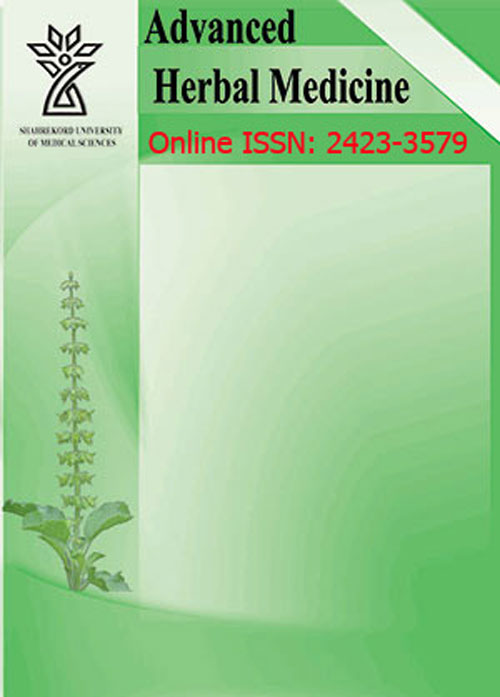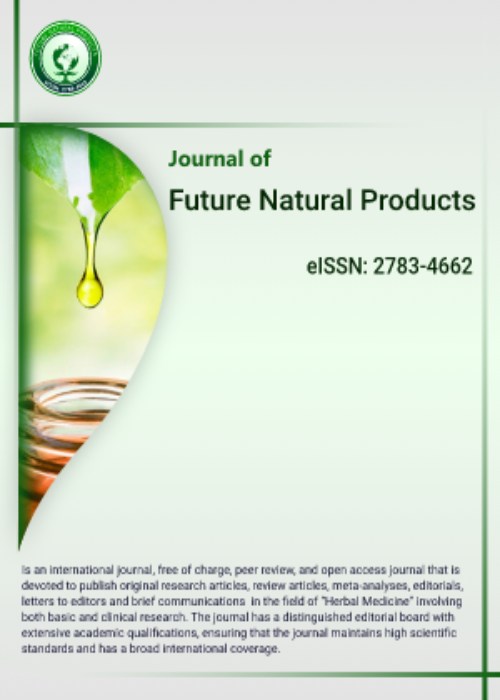فهرست مطالب

Future Natural Products
Volume:5 Issue: 1, Winter 2019
- تاریخ انتشار: 1398/10/25
- تعداد عناوین: 5
-
Pages 1-13Backgruon and aimsThe aim of this research was to compare the chemical composition and the antioxidant and antibacterial properties of wild and cultivated types of T. fedtschenkoi collected from East Azarbayjan, Iran.Material and MethodsThe essential oils (EOs) from aerial parts of wild and cultivated T. fedtschenkoi were investigated by gas chromatography/mass spectrometry (GC/MS). Antibacterial activities of EOs and methanol extracts were tested against bacteria by disc diffusion method and determining their minimum inhibitory concentration (MIC) values by agar dilution method and antioxidant activity by DPPH and FRAP assays.ResultsTwenty-two components were identified representing more than 99.20% of the total oil constituents. The major components in the oils of the wild type were; thymol (49.21%), p-cymene (15.20%) and Carvacrol (10.20%) and for the cultivated type were; thymol (62.33%) and carvacrol (7.12%). The MIC values of bacterial strains, which were sensitive to the EO of T. fedtschenkoi, were in the range of 2-128 μg/mL in wild type and 2-16 μg/mL in cultivated type.ConclusionOur data show that cultivation significantly affects the EOs’ chemical composition and antioxidant potential of T. fedtschenkoi. They signify a reasonable source of natural antibacterial substances that proved to be potential as a drug for use in pathogenic bacteria.The antibacterial activity by the presence of inhibition zone appeared from EOs in the cultivated type on all tested microorganisms significantly higher than that in the wild type, which can be attributed to the presence of high concentration of thymol (47.48%) against the wild type (29.96%).Keywords: Biological activity, cultivation, Essential oil composition, Thymus fedtschenkoi
-
Pages 14-22Background and aimsIn bacteria using inhibitors of efflux pumps (EPIs) is one of several strategies to combat with bacterial resistance. It is well documented that most medicinal plants especially those with antimicrobial properties composed of elements (EPIs) that disturb the efflux pumps of bacteria. The current work was designed to evaluate antibacterial activities of ethanol and chlorophorm extracts of Melissa officinalis and also synergistic effects of the extracts with ciprofloxacin against some gram negative pathogenic bacteria. We also examined the inhibitory effects of the extracts on efflux pumps.MethodsMinimum inhibitory concentrations (MICs) of the extracts alone or in association with ciprofloxacin or phenylalanine arginine β- naphtylamide (PAβN) were determined using broth micro dilution method. Effects of the extracts on efflux pumps of the examined bacteria detected by using ethidium bromide in well diffusion assays.ResultsThe extracts from M. officinalis showed antibacterial activities against all examined bacteria in a range of 3125 to 25000 μg/mL as determined by MIC determination. The extracts from M. officinalis showed synergistic effects with ciprofloxacin on Salmonella enteritidis and Escherichia coli. In Pseudomonas aeruginosa and Acinetobacter baumannii PAβN had no effect on MIC of ciprofloxacin but the association of extracts decreased it. In S. enertidis and E Coli both extracts of M. officinalis increased the amount of ethidium bromide accumulation (i.e. reduced efflux).ConclusionThe overall results show that associations of fluoroquinolones with extracts of M. officinalis may potentiate the antibacterial effects of fluoroquinolones.Keywords: Antibacterial activities, Melissa officinalis, Gram-negative bacteria, Efflux pumps
-
Pages 21-40Background
Sickle cell anaemia induces an abnormal haemoglobin (Hb S) synthesis. Hb S undergoes polymerization and causes the red blood cell (RBC) sickling with the production of reactive oxygen species (ROS). The present work aims to determine the antioxidant and anti-sickling activities of the combination of Theobroma cacao (T. cacao) extracts from different regions in Cameroon.
MethodsThe extract combinations (Santchou and Obala (CSOH), Bertoua and Mbalmayo (CMBH)) was prepared using water/ethanol (30v/70v; pH=3). Ferric Reducing Antioxidant Power (FRAP), 2,2-diphenyl-1-picrylhydrazyl (DPPH°) and 2,2'-azino-bis-[3-ethylbenzo-thiazolone-6-sulfonic acid] (ABTS°) scavenging properties of extracts were determined for the antioxidant capacity. The liver homogenate protective activity of extracts was estimated by measuring Superoxide dismutase (SOD), glutathione peroxidase (GPX), Malondialdehyde (MDA) and reduced glutathione (GSH). Osmotic fragility reduction and anti-sickling properties of the combination were also investigated.
ResultsCSOH and CMBH respectively revealed a high content of polyphenols (274.6±5.1 and 289±2 mg Eq of Quercetin/g of extract), flavonoids (3.8±0.1 and 4±0.2 mg Eq of cafeic acid/g of extract) and FRAP (119.83 MEAA/g of extract and 114.33 MEAA)/g of extracts). Extracts scavenged DPPH° and ABTS° radicals, respectively with IC50 values between 4.07 μg/mL and 13.15 μg/mL. CMBH showed the best anti-sickling reduction activity (54.56% and 70.07% after 2h30 and 24h respectively). The haemolysis percentage of erythrocytes decreased with an increase of the extract concentrations. Extracts combinations decreased and increased the MDA and GSH levels respectively as well as normalizing the enzymatic activities.
ConclusionCocoa extracts combinations especially CMBH are antioxidants and anti-sicklings.
Keywords: Sickle cell anaemia (SCA), Oxidative stress, T. cocoa combination -
Pages 41-52aimsThe aim of this study was to characterize the chemical composition and antimicrobial properties of Achillea biebersteinii essential oil (EO).MethodsThe chemical composition of samples obtained from Marand city in East Azerbaijan, was assessed using gas chromatography-mass spectrometry (GC-MS). The antimicrobial properties were evaluated by the disc diffusion method against methicillin-resistant Staphylococcus aureus (MRSA), other extended-spectrum beta-lactamases (ESBLs) producing, as well as Gram-negative and Gram-positive bacteria. The minimum inhibitory concentration (MIC) value of EO was assessed using the agar dilution method.ResultsIn A. biebersteinii the major compounds were α-terpinene (41.42%), 2-carene (13.96%), m-cymene (13.41%) and 1,8-cineole(8.91%).The EO showed antimicrobial activity against ten microorganisms, especially Streptococcus sanguis, S. aureus (MRSA strain), and Klebsiella pneumoniae (ESBL-producing strain), which was potentially better than tetracycline and kanamycin.ConclusionThis study confirmed that EO of A. biebersteinii has in vitro antimicrobial activity against Gram-negative and Gram-positive bacteria, which has made it an alternative antibacterial agent.Keywords: Phytochemicals, Achillea biebersteinii, essential oil, GC, MS
-
Pages 49-56Background and aims
Belonging to the Apiaceae family, Smyrnium cordifolium Boiss. Is commonly known as Avandul in Iran. However, there is limited information about this plant and S. cordifolium has been regretfully neglected in Iran. This review was an effort to provide detailed information on phytochemistry and pharmacological effects of Smyrnium cordifolium growing in Iran, aimed at taking the first steps towards introducing the species for further future investigations.
MethodsThe information of this review was obtained by searching for keywords Apiaceae, Smyrnium cordifolium, pharmacological effects and phytochemistry in scientific articles and books published in search engines Scopus, Google Scholar, Science Direct, PubMed, and Web of Science.
ResultsThis plant is aromatic owing to the presence of essential oil. The Sesquiterpens, monoterpenes and flavonoids were reported as the major constituents of essential oil, and in the traditional medicine of Iran, it was used to treat anxiety, pain, insomnia and as vegetables. Curative application of this national wealth has only been considered from ethnobotanical point of view among indigenous people of the country.
ConclusionWith regard to medicinal and nutritional importance of S. cordifolium, it can be used in the pharmaceutical and food industry, and also may be effective for diseases of the bladder and kidneys. Despite that, the bioactivities of S. cordifolium have been confirmed in vitro and in vivo studies; however, more studies clinical are required on the bioactivities.
Keywords: Medicinal plants, Phytochemistry, Smyrnium cordifolium Boiss, Avendol


